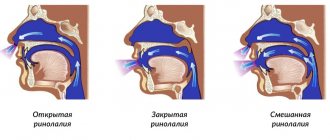Article:
Tachylalia, or accelerated speech rate, is a neuropsychiatric disorder and often manifests itself against the background of a primary disease - nervous or mental.
A speech disorder is accompanied by repetitions of words, “swallowing” of endings, hesitations, and incorrect pronunciation of words or syllables. Children who are excitable, hyperactive, or diagnosed with ADHD (attention deficit hyperactivity disorder) are especially susceptible to it. Therefore, the diagnosis and treatment of tachylalia is approached comprehensively. It is necessary, first of all, to identify and eliminate the cause of the disease - this is the only way to achieve good results. Otherwise, the disease can remain with the person for life and create many difficulties.
Classification of speech impairment by type of tachylalia
Normally, a person speaks 10 - 12 sounds per second, with an accelerated rate of speech - up to 30.
There are 3 forms:
- Clean . The child speaks at an accelerated pace, but without grammatical, phonetic, or lexical errors;
- Battarism , or paraphasia. The child “chokes” and cannot finish the sentence he has started. This occurs due to impaired speech breathing. In some cases, children construct lexical constructions incorrectly;
- Poltern , or stumbling. In this case, there are too many hesitations and pauses in the child’s speech, he cannot find the right words, repeats words or syllables that have already been spoken, and it is difficult for him to express his thoughts.
In addition, there are several types of polternes with different disorders: motor (in this case, the child not only speaks quickly, but also pronounces sounds incorrectly), sensory (auditory attention is impaired), with difficulties in selecting words and formulating speech.
How to distinguish the types of tachylalia?
Children with tachylalia are not only in a hurry to speak, this condition, as a consequence of disruption of the nervous system, has a number of characteristic signs:
- Hesitations, repetitions, swallowing of syllables and even words.
- Inner speech disorders.
- Accelerated, fidgety motor movements. Excitement even in sleep.
- Reduced memory capacity
- Hot temper, irritability, sudden aggression.
- Impairments in written speech.
- Improper breathing during conversation. The child is in such a hurry to say something that he does not always even have time to draw in air to breathe. Accordingly, both the timbre of speech and its expressiveness are impaired. Speech becomes monotonous, without color.
- Decreased concentration, abnormal social behavior. The child begins to speak without listening to the interlocutor, without understanding the question.
- Tachylalia may be associated with language impairment in ADHD.
If parents notice such problems in their child, it would be better to quickly contact specialists to select a competent correction. After all, there are not only problems with understanding the child’s speech by other interlocutors, but also obvious neurological disorders.
The good news is that speech therapists can successfully cope with such speech disorders. Moreover, the sooner parents notice the problem and seek help, the faster the child’s correct speech can be restored. Moreover, such problems with speech leave an imprint on the success of learning at school.
Causes of speech disorders
The causes and mechanisms of tachylalia are based on psychogenic and somatic factors, as well as habit. At risk are children with an unbalanced psyche, hyperactive, and easily excitable.
If one of your immediate blood relatives is diagnosed with tachylalia, the risk of developing it in your child increases.
The development of the disease can be triggered by a brain tumor, traumatic brain injury, neuroinfection or mental disorder - schizophrenia, for example.
A social factor cannot be excluded - mistakes in raising a child, when he is encouraged to imitate the fast speech of adults.
Reasons for the development of tachylalia
In speech therapy practice, the causes of tachylalia are different, and there are many opinions, among which the following theories about the causes of the development of tachylalia are distinguished:
- genetic predisposition;
- imitation on the part of the child of the fast pace of speech of others;
- improper speech education.
Most often, unbalanced, hyperactive children with increased excitability are susceptible to tachylalia. At the same time, the manifestation of speech disorders in childhood can worsen in adolescence and accompany a person throughout his life.
Sometimes tachylalia develops against the background of the growth of brain tumors or against the background of other brain pathologies (TBI, neuroinfections, epilepsy). Also, the causes of tachylalia can be various psychiatric pathologies: this is the development of schizophrenia, manic-depressive psychosis, etc.
By the nature of its development, tachylalia is a certain process of dominance of excitation over inhibition, which entails a violation of the tempo of internal and external speech.
Symptoms of tachylalia in children
The most characteristic symptoms can be divided into several groups:
1. Features of speech. She is very fast and inarticulate, making her extremely difficult to understand. It is dominated by repetitions, “swallowing” of endings, and rearrangement of syllables;
2. Reading and writing skills. Patients with tachylalia have difficulty in this area;
3. Features of general motor skills. The movements are rapid, nervous, the child is fussing;
4. Problems with attention and memory. The child quickly switches attention, cannot concentrate on one thing, has poor memory;
5. Reactions of the autonomic nervous system. If a child is excited, his face turns red, his heart rate increases, and he sweats.
These symptoms are a reason to show the child to a neurologist.
General information
Tachylalia, like bradylalia (slow speech rate), is a non-convulsive disorder and is a violation of the rhythmic organization of speech. In this condition, the speech flow is very fast, which makes it much more difficult for others to understand what is being said. With tachylalia, the speed of all mental processes increases: the child speaks very quickly and writes unintelligibly, experiences motor restlessness, cannot maintain attention and instantly switches from one task to another.
Comprehensive diagnosis of the disease
Several specialists take part in the diagnosis of the disease - a neurologist, a psychiatrist, a speech therapist.
A neurologist assesses the neurological status of a small patient, and a psychiatrist identifies mental abnormalities.
Before a child is diagnosed, extensive testing is performed to determine organic causes of tachylalia. For this use:
- Hardware diagnostics - MRI of the brain, electroencephalography (EEG), echoencephalography (Echo-EG);
- Diagnostics of speech - oral, written.
Based on the data obtained during the diagnosis, the little patient is diagnosed and prescribed a treatment regimen.
What examination is needed
Diagnosis is carried out by a neurologist, psychologist and speech therapist, sometimes by a neuropsychologist. To identify neurological lesions, it is necessary to undergo an examination with specialists with the child. You will probably need an EEG, echo-EG. A neurologist and psychologist will assess your intellectual and mental state and identify possible disturbances in the functioning of the nervous system. A speech pathologist-defectologist must assess the state of speech “from his own point of view.” Speech therapy status and additional violations of speech abilities will require changes in correctional tactics. Trust the specialists - a thorough examination will allow you to create the most effective correction tactics.
An integrated approach to treatment
Correction of tachylalia is also approached in a comprehensive manner. Here are the areas in which doctors work:
- Medical impact. This group includes: drug therapy, exercise therapy, massage;
- Psychotherapy. Body-oriented therapy and art therapy are considered the most effective;
- Speech therapy correction of tachylalia. Group classes give the best results.
Only a combination of the listed approaches gives positive dynamics. Next, we will consider the techniques that are used to correct tachylalia in children.
Breathing gymnastics: a set of exercises
It is important to count when doing exercises. First, the adult does this, and after a while, the child himself does it.
Exercise one. Inhale for 1 – 2 – 3, then pause for a count of 1 and exhale also for 1 – 2 – 3. Inhale through the nose, exhale through the mouth. In one approach, the child does from 4 to 6 cycles. Repeat the exercise several times a day.
Exercise two. The child takes a step and inhales, another step and exhales, and pauses on the third step. Perform one approach for no longer than 3 minutes. Do the exercise several times a day, at home or on the street.
Exercise three. The child inhales deeply, exhales for at least 4 seconds and pronounces the consonants. It is important not to puff out your cheeks; repeat each letter at least 4 times.
Logorhythmics - learning to speak slowly
All exercises to correct tachylalia must be done slowly - this is the only way they will be effective. Duration - from 3 to 5 minutes.
Exercise one. The child claps his hands once and says a word for each clap. This could be the name of a city, a fruit, a vegetable—the groups are selected randomly, depending on the child’s knowledge and age.
Exercise two. The baby walks and counts. While counting, he says one word - as in the first exercise, this can be the name of anything. It is not so much the meaning of what is said that is very important, but the slow and clear pronunciation of each word.
Exercise three. This exercise is good to do at home. Parents scatter toys around the room and give the baby a bucket. He walks around and collects toys in it. First, he takes the toy in his hands, clearly and slowly names it and puts it in the bucket.
Music therapy: developing a sense of rhythm
What, if not music, contributes to the development of a sense of rhythm? Speech therapists actively use rhythmic music in their classes. It improves the functioning of the brain and its connections with the body. As a result, children's attention improves, they cope better with stress and express their thoughts.
Interactive metronome - modern technology
Another technique that is used in working with children with speech disorders, mental retardation and other diagnoses. A metronome stimulates brain activity, as a result of which it better processes information coming from outside. As a result, the child’s behavioral reactions stabilize, he learns to plan his activities, and his neurodynamics improve.
Accepting a slow speech rate
Here are some options for tasks for children:
- an adult plays an audio recording with text at a slow pace. The child listens to it and retells it just as slowly;
- the adult slowly pronounces the phrase, then repeats it just as slowly with the baby;
- singing at a slow tempo.
Exercises to correct tachylalia can be repeated several times a day for a maximum of 5 minutes.
Working with text: task options
You can work with text in several directions.
First, ask your child to slowly tell a story or tale.
Secondly, the adult tells the child a few words, from which he must make a sentence with meaning.
Here are some exercises for little patients who can read. For example, a child is given a text that he must then retell. You can also read to the beat, loudly, or, conversely, to yourself. A regular conversation in the form of a question and answer, listening to images of correct speech, is effective.
Corrective work lasts from six months to a year.
Learning to speak slowly
Speech therapy work for tachylalia mainly consists of accustoming the child to a normal speech rate. All exercises are performed in a playful way. A speech therapist works with a group of children. Standard lesson program:
- A certain group of words is selected by age - vegetables, fruits, cities, animals. Then the child says the corresponding word and claps his hands.
- A similar task, but instead of clapping, the baby takes a step and counts.
- Various toys are scattered across the floor. The baby must pick up any of them, name them and put them in a bucket.
The exercises are performed slowly (3–5 minutes each). It is important to ensure that every word is pronounced clearly. Otherwise, the desired effect simply will not happen. It is advisable for adults to be directly involved in the process, allowing the child to “win.”
To achieve results, it is necessary to take an integrated approach, that is, immediately start taking all the courses prescribed by specialists: giving medications, doing exercise therapy, doing massage, etc.
Prevention of tachylalia in children
The development of a speech disorder can be prevented by a careful and responsible attitude towards the child’s health - ensuring his safety in order to avoid traumatic brain injuries and infections. It is also important to visit your pediatrician regularly to promptly diagnose possible problems - brain tumors, mental or nervous disorders.
Preventive measures also include timely treatment of identified diseases, including injuries. As well as correction of behavioral disorders, poor memory, hyperactivity.
It is important that parents do not turn a blind eye to the baby’s health problems, hoping that “it will go away on its own.”
Symptoms of polternism and battarism.
With battarism and polternism, there are also both speech and non-speech symptoms.
1. Impaired oral speech (haste, disturbances in the formation of individual sounds, rearrangements, omissions, changes in sounds and syllables, loss of words and phrases). Speech consists of short, unrelated sentences.
2. Stumbling in speech. The sound is not pronounced immediately. The lips and tongue may move silently, resembling convulsive movements.
3. Breathing and diction problems.
4. Voice disorders (no sonority, monotony, symptoms of voice overstrain)
5. Reading disorders (when reading, long phrases are divided into short ones, the main idea of what is being read is lost).
6. Violations of writing (stopping the hand in the process, omissions, substitutions, rearrangements of syllables and letters, words and entire phrases).
7. General motor skills are impaired (swiftness, quick turns, scattered movements, grimaces).
8. Instability of attention (they don’t know how to listen to others, they don’t catch thoughts well and don’t remember them)
9. Scattered thinking, lack of logic.
10. Uncritical (they often do not notice their defect, adults rarely seek help themselves).
Forecasts of tachylalia in children
Only the attending physician can tell what results and when you can expect. This depends on many factors - the severity of the speech disorder, the general health of the baby, the timeliness of correction and the efforts made by the parents and the child himself (including work at home).
If parents pay enough attention to the child, work with him, and follow all the doctor’s instructions for developing speech skills, then the prognosis is more than positive. The main thing is not to be lazy and follow all the specialist’s recommendations.
Correcting a speech disorder is a difficult and long journey, but it is necessary to go through it for the sake of your child’s future. Otherwise, the disease can cause social and personal problems, including depression.
Corrective work for tachylalia
Measures to correct tachylalia should be applied comprehensively. Since changes in speech have a clear neurological cause, it is necessary that the work of a speech therapist be combined with neurological observation and treatment. To correct disturbances in the functioning of the nervous system, drug treatment is usually prescribed. Physiotherapy, exercise therapy and all possible measures used at home to stabilize the nervous system and bring it into balance would be useful in this situation. Parents must remember that the child needs a strict daily routine, maintaining a calm atmosphere in the house and, most importantly, supporting the child and monitoring the implementation of all tasks of the speech therapist.









